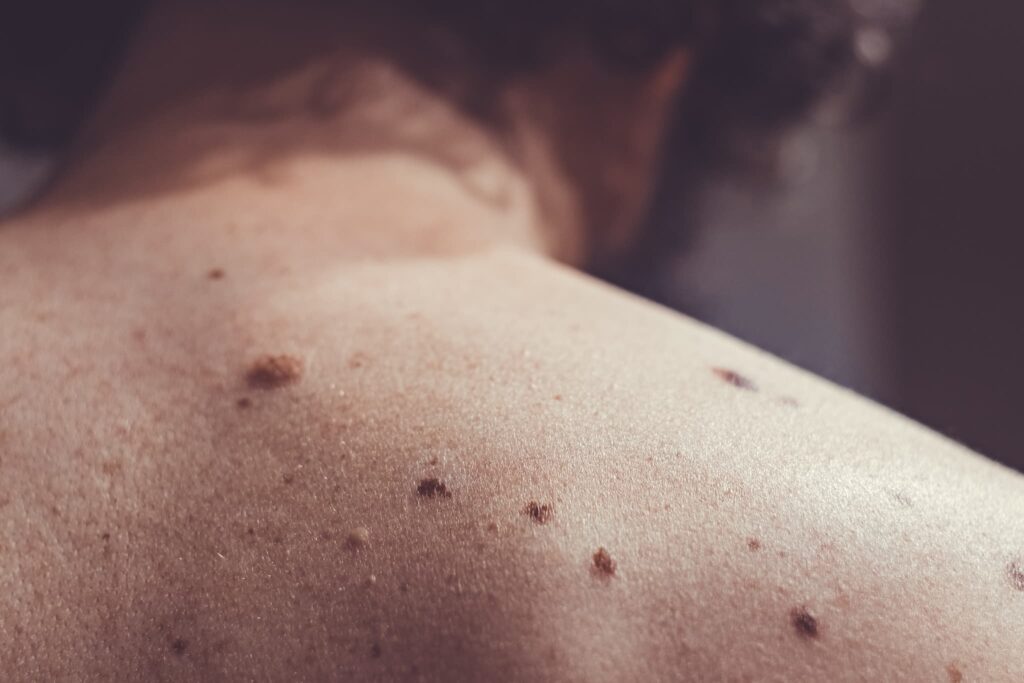Posted by: Skin And Cancer Institute in Skin Cancer

Precancerous skin lesions are not cancer but could become cancer over time. These lesions include actinic keratosis.
Actinic Keratosis
The most common form of precancer is actinic keratosis (AK). It is also known as solar keratosis because it’s caused by long-term exposure to the sun’s ultraviolet (UV) rays. AKs can eventually develop into squamous cell carcinoma.
What’s Squamous Cell Carcinoma?
The second most common form of skin cancer, squamous cell carcinoma affects millions of people each year. This type of carcinoma is made up of flat squamous cells that live near the middle and outer layers of the skin. Ultraviolet radiation can trigger abnormal changes in the squamous cell. Squamous cell carcinoma develops from precancerous actinic keratoses.

What Actinic Keratosis Looks Like
Actinic keratosis looks like patches of skin anywhere from flesh-toned to red, tan, white, pink, or a combination of colors.
How do They Feel?
They are sometimes raised and are dry and scaly. Actinic keratosis’s rough texture can make it easier to feel than see. Your skin might be:
- Dry
- Raw
- Sensitive
- Painful
- Itchy
- Burning
- Inflamed
What Else Should You Know About Actinic Keratosis?
The precancerous growth often shows up on the parts of the body that get the most sun, like the scalp, face, neck, shoulders, arms, and hands.
Stay Away From The Sun
Avoiding the sun’s ultraviolet (UV) rays is the single best thing you can do for yourself to prevent developing Actinic Keratosis. But if you already have AK you should still avoid the sun to reduce the risk of this precancerous lesion turning cancerous over time.
Tips For Staying Safer in The Sun
No sun exposure is the healthiest option for your skin. But because you can’t avoid the sun entirely, it’s best to minimize your exposure. Wear a broad-spectrum sunscreen daily and reapply it as it loses effectiveness as the hours wear by. Sun protective clothing is helpful, too. Try wearing long, light layers of breathable cotton or linen. A hat and sunglasses are essential, as is finding shade whenever possible. And avoid being outdoors when the sun is most intense, which is generally from 10 am to 4 pm.
Keep an Eye on Your Growths
The main thing to remember is that cancer often starts as a change to an existing growth. That’s why it’s vital to keep an eye on your dry, scaly keratosis spots if you have them. Look out for new or evolving growths, especially if they bleed.
Treatment
If you have AK, there are plenty of treatment options for you. These include:
- At-home treatment: Your dermatologist may prescribe medicated creams for your skin.
- Chemical peels: Gently destroy unwanted patches in your top layer of skin.
- Cryotherapy: Freezes AKs with liquid nitrogen.
- Excision: Your dermatologist will cut out the AKs.
- Photodynamic therapy: This treatment destroys AKs with creams and light therapy.
See a Dermatologist
A dermatologist can help you by performing an annual skin exam to determine if your skin growths are precancerous. This early detection makes them highly treatable before they develop into skin cancer. Everyone should see a dermatologist for an annual exam, but this is especially true for people with Actinic Keratosis—they should be under a dermatologist’s care. Ready to begin your journey to healthier skin? Schedule and appointment with the Skin and Cancer Institute today.